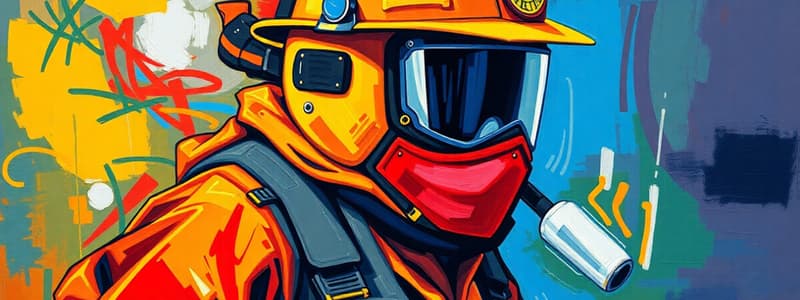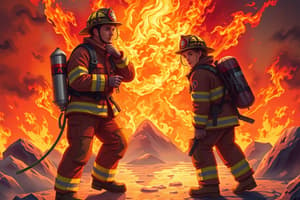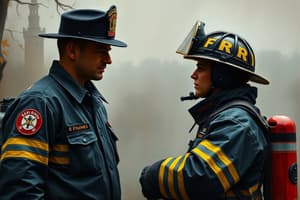Podcast
Questions and Answers
What is the primary goal of a safety program for reducing firefighter injuries or deaths?
What is the primary goal of a safety program for reducing firefighter injuries or deaths?
- Increasing community awareness about fire risks
- Focusing solely on equipment improvements
- Integrating important components such as regulations and training (correct)
- Maximizing resource allocation
Which of the following is NOT one of the three categories of methods for managing risk?
Which of the following is NOT one of the three categories of methods for managing risk?
- Personnel protection
- Financial investments (correct)
- Engineering controls
- Administrative controls
What component is considered a part of the risk management process?
What component is considered a part of the risk management process?
- Allocating funds for luxury items
- Ignoring past incident data
- Neglecting potential hazards
- Monitoring solutions after implementation (correct)
What represents the first step of the five principal risk management steps?
What represents the first step of the five principal risk management steps?
What is now considered the leading cause of death among firefighters?
What is now considered the leading cause of death among firefighters?
Which behavioral health intervention is showing promise in reducing firefighter suicides?
Which behavioral health intervention is showing promise in reducing firefighter suicides?
Which of the following best describes personnel protection in the context of risk management?
Which of the following best describes personnel protection in the context of risk management?
What are the responsibilities of a fire chief regarding community risk management?
What are the responsibilities of a fire chief regarding community risk management?
What risk do firefighters have compared to the general population regarding cancer?
What risk do firefighters have compared to the general population regarding cancer?
Which action is NOT mentioned as a best practice for preventing firefighter cancer?
Which action is NOT mentioned as a best practice for preventing firefighter cancer?
Which injury accounted for the highest percentage of firefighter injuries in the NFPA's 2017 report?
Which injury accounted for the highest percentage of firefighter injuries in the NFPA's 2017 report?
What is a primary non-cardiac cause of death during fire suppression operations?
What is a primary non-cardiac cause of death during fire suppression operations?
What is the outcome of the Evaluate and Revise Risk Control Actions step in risk management?
What is the outcome of the Evaluate and Revise Risk Control Actions step in risk management?
According to NFPA 1500, who is responsible for ensuring that the driver adheres to traffic rules during emergency responses?
According to NFPA 1500, who is responsible for ensuring that the driver adheres to traffic rules during emergency responses?
Which of the following could potentially prevent multiple firefighter fatalities each year?
Which of the following could potentially prevent multiple firefighter fatalities each year?
What contributes significantly to fatalities among single firefighter incidents?
What contributes significantly to fatalities among single firefighter incidents?
What is a primary responsibility of the Incident Safety Officer (ISO) at an incident scene?
What is a primary responsibility of the Incident Safety Officer (ISO) at an incident scene?
Which certification is required for a person to serve as an ISO according to NFPA 1521?
Which certification is required for a person to serve as an ISO according to NFPA 1521?
Which of the following best describes Incident Scene Rehabilitation?
Which of the following best describes Incident Scene Rehabilitation?
What is the role of the Assistant ISO during an emergency incident?
What is the role of the Assistant ISO during an emergency incident?
What should be done when an unsafe condition does not present imminent danger?
What should be done when an unsafe condition does not present imminent danger?
Why is it crucial for the Fire Officer (FO) to monitor the health of members on scene?
Why is it crucial for the Fire Officer (FO) to monitor the health of members on scene?
What is one of the summarizing principles concerning incident scene rehabilitation according to the National Fallen Firefighters Foundation (NFFF)?
What is one of the summarizing principles concerning incident scene rehabilitation according to the National Fallen Firefighters Foundation (NFFF)?
What should every injury or near miss at an incident scene be considered as?
What should every injury or near miss at an incident scene be considered as?
What is a recommended method for reinforcing safety policies?
What is a recommended method for reinforcing safety policies?
Which of the following sources can be accessed to review safety policies?
Which of the following sources can be accessed to review safety policies?
Who is responsible for determining if it is safe to reduce PPE levels?
Who is responsible for determining if it is safe to reduce PPE levels?
What should be included in the gear inspection process?
What should be included in the gear inspection process?
What is a key component of an Infection Control Program?
What is a key component of an Infection Control Program?
Which of the following practices should be avoided in a fire department to minimize injury risk?
Which of the following practices should be avoided in a fire department to minimize injury risk?
Which standard is associated with maintaining a workplace safety program in fire departments?
Which standard is associated with maintaining a workplace safety program in fire departments?
What is the proper solution for cleaning equipment, as per safety guidelines?
What is the proper solution for cleaning equipment, as per safety guidelines?
What is the first action to take after an exposure to an infectious disease?
What is the first action to take after an exposure to an infectious disease?
Which individual is primarily responsible for ensuring all hazardous conditions and accidents are thoroughly investigated?
Which individual is primarily responsible for ensuring all hazardous conditions and accidents are thoroughly investigated?
What should be included in the record of an exposure incident?
What should be included in the record of an exposure incident?
How should data on exposure incidents be maintained for analysis?
How should data on exposure incidents be maintained for analysis?
What is the primary responsibility of the Fire Operations officer (FO) regarding accidents?
What is the primary responsibility of the Fire Operations officer (FO) regarding accidents?
In the context of an accident, what is not typically part of the investigation process?
In the context of an accident, what is not typically part of the investigation process?
Who is responsible for determining a member's fitness-for-duty status after an exposure?
Who is responsible for determining a member's fitness-for-duty status after an exposure?
What should always result from an accident investigation?
What should always result from an accident investigation?
What is a crucial aspect of the final step in an accident investigation?
What is a crucial aspect of the final step in an accident investigation?
What is the primary goal of the Everyone Goes Home program?
What is the primary goal of the Everyone Goes Home program?
Which factor contributes the highest to on-duty firefighter deaths?
Which factor contributes the highest to on-duty firefighter deaths?
What role does an ISO play during an incident?
What role does an ISO play during an incident?
What is the purpose of the firefighternearmiss.com program?
What is the purpose of the firefighternearmiss.com program?
Why is it important for a forward officer (FO) to perform a fair investigation?
Why is it important for a forward officer (FO) to perform a fair investigation?
What does risk management involve in an organizational context?
What does risk management involve in an organizational context?
When might it be necessary to assign more than one safety officer at an incident?
When might it be necessary to assign more than one safety officer at an incident?
Flashcards
Risk Management
Risk Management
The process of planning, organizing, directing, and controlling the resources and activities of an organization to minimize detrimental effects. It involves identifying and analyzing risks, formulating and implementing solutions, and monitoring for effectiveness.
Identify Risk Exposure (Fire Department)
Identify Risk Exposure (Fire Department)
Identifying and analyzing risks that could harm the fire department, its members, or the community.
Evaluate Risk Exposure
Evaluate Risk Exposure
Determining the likelihood of a risk occuring and the potential consequences. This helps prioritize risks based on their severity and probability.
Rank and Prioritize Risks
Rank and Prioritize Risks
Signup and view all the flashcards
Determine and Implement Risk Management Control Actions
Determine and Implement Risk Management Control Actions
Signup and view all the flashcards
Evaluate and Revise Risk Control Actions
Evaluate and Revise Risk Control Actions
Signup and view all the flashcards
Common Firefighter Injuries
Common Firefighter Injuries
Signup and view all the flashcards
Firefighter Fatalities
Firefighter Fatalities
Signup and view all the flashcards
Firefighter Cancer
Firefighter Cancer
Signup and view all the flashcards
Gross Decontamination
Gross Decontamination
Signup and view all the flashcards
NFPA 1500 Standard
NFPA 1500 Standard
Signup and view all the flashcards
Running Out of Air in IDLH
Running Out of Air in IDLH
Signup and view all the flashcards
Behavioral Health
Behavioral Health
Signup and view all the flashcards
Incident Management System (IMS)
Incident Management System (IMS)
Signup and view all the flashcards
Peer Support Programs
Peer Support Programs
Signup and view all the flashcards
Internal Trauma/Crushing
Internal Trauma/Crushing
Signup and view all the flashcards
Infectious Disease Exposure Protocol
Infectious Disease Exposure Protocol
Signup and view all the flashcards
Exposure Incident Record
Exposure Incident Record
Signup and view all the flashcards
Accident Investigation
Accident Investigation
Signup and view all the flashcards
Health and Safety Officer
Health and Safety Officer
Signup and view all the flashcards
Fitness-for-Duty Assessment
Fitness-for-Duty Assessment
Signup and view all the flashcards
Fire Officer's Role in Accidents
Fire Officer's Role in Accidents
Signup and view all the flashcards
Accident Investigation Phases
Accident Investigation Phases
Signup and view all the flashcards
Corrective Actions in Accident Investigation
Corrective Actions in Accident Investigation
Signup and view all the flashcards
Policy review method
Policy review method
Signup and view all the flashcards
Reinforcing safety policies
Reinforcing safety policies
Signup and view all the flashcards
Sharing safety information
Sharing safety information
Signup and view all the flashcards
Who decides PPE level?
Who decides PPE level?
Signup and view all the flashcards
Essential equipment for firefighters
Essential equipment for firefighters
Signup and view all the flashcards
What is the role of the Incident Safety Officer (ISO)?
What is the role of the Incident Safety Officer (ISO)?
Signup and view all the flashcards
Station clothing as PPE
Station clothing as PPE
Signup and view all the flashcards
Fire department safety responsibility
Fire department safety responsibility
Signup and view all the flashcards
How does the ISO communicate with the IC?
How does the ISO communicate with the IC?
Signup and view all the flashcards
What is the ISO's primary role at an incident scene?
What is the ISO's primary role at an incident scene?
Signup and view all the flashcards
Infection control program
Infection control program
Signup and view all the flashcards
What does the ISO do when encountering a non-critical unsafe condition?
What does the ISO do when encountering a non-critical unsafe condition?
Signup and view all the flashcards
What is the purpose of an Assistant ISO?
What is the purpose of an Assistant ISO?
Signup and view all the flashcards
What is the ISO's responsibility regarding firefighter rehabilitation?
What is the ISO's responsibility regarding firefighter rehabilitation?
Signup and view all the flashcards
Why is firefighter fatigue and dehydration a serious concern?
Why is firefighter fatigue and dehydration a serious concern?
Signup and view all the flashcards
What is the ISO's significance in ensuring firefighter safety?
What is the ISO's significance in ensuring firefighter safety?
Signup and view all the flashcards
What is Risk Management?
What is Risk Management?
Signup and view all the flashcards
What is the "Everyone Goes Home" program?
What is the "Everyone Goes Home" program?
Signup and view all the flashcards
Who is the ISO?
Who is the ISO?
Signup and view all the flashcards
What is the first step of an accident investigation?
What is the first step of an accident investigation?
Signup and view all the flashcards
What is the last step of an accident investigation?
What is the last step of an accident investigation?
Signup and view all the flashcards
What is the purpose of www.firefighternearmiss.com?
What is the purpose of www.firefighternearmiss.com?
Signup and view all the flashcards
What is the leading cause of on-duty firefighter deaths?
What is the leading cause of on-duty firefighter deaths?
Signup and view all the flashcards
What is the rate of firefighter suicide compared to LODD?
What is the rate of firefighter suicide compared to LODD?
Signup and view all the flashcards
Study Notes
CO Book Chapter 8
- Reducing firefighter injuries and fatalities requires a comprehensive safety program integrating regulations, standards, procedures, personnel, training, and equipment.
- Risk management involves identifying and analyzing risk exposures, formulating solutions, implementing them, and monitoring results.
- Fire chiefs' roles in risk management include managing community fire risk, providing services, and maintaining FD readiness.
- Risk management methods include administrative, engineering, and personnel protection controls.
- Administrative controls use guidelines, policies, and procedures to minimize losses.
- Engineering controls utilize built-in systems to eliminate or limit hazards.
- Personnel protection involves equipment, clothing, and devices for personnel safety.
- Five principal steps in risk management are identifying risk exposure, evaluating risk exposure, ranking and prioritizing risks, determining and implementing control actions, and evaluating and revising control actions.
- NFPA's 2017 report shows strains/sprains (48%), wounds/cuts (15%), smoke/gas inhalation (7%), and thermal stress (5%) as common firefighter injuries.
- Fire ground fatalities have been approximately 26 per year since 2007.
- Sudden cardiac arrest (39%), internal trauma (36%), asphyxia (9%), other (8%), burns (5%), and unspecified medical (3%) were the leading causes of death in 2017.
- The Everyone Goes Home program, developed by NFPA, aims to raise awareness about safety, improve practices, and ensure everyone returns safely.
- Culture change, accountability, risk management, empowerment, training and certification, medical and physical fitness, research, technology, fatality investigation, and policy development are prioritized to create a safer work environment.
- Psychological support, public education, code enforcement, sprinklers, and apparatus design and safety are incorporated into a standard approach to safety.
- IAFC Near Miss Reporting System helps identify trends and share information in a confidential way.
- Physical fitness activities, lifestyle modifications, and training programs should improve firefighter safety.
Risk Management Steps
- Identify risk exposure: Identifying factors that pose harm or potential loss
- Evaluate risk exposure: Assessing the probability of injury or loss event
- Prioritize risks: Determining the potential severity and frequency of risks
- Implement control actions: Planning actions to minimize or eliminate risks
- Evaluate and revise control actions: Reviewing implemented actions and altering them if needed.
Firefighter Safety Initiatives
- NFPA 1583 outlines health-related fitness programs.
- Addressing behavioral health concerns is important for promoting firefighter well-being
- Prevention of cancer hazards like PPE usage is critical for firefighter safety.
- Preventing vehicle collisions by emphasizing traffic laws, seat belt use, and avoiding reckless driving.
- ISO and other safety officers play a major role in incident scene operations.
- Rehabilitation, medical evaluation, and supportive strategies are crucial for handling strenuous or long-duration tasks.
- Infection control measures are essential for managing outbreaks.
- Accident investigation involves identifying causes, interviewing witnesses, and suggesting preventative measures.
- A comprehensive safety program includes physical fitness, personal protective equipment (PPE) use, and adherence to safety policies and procedures.
Studying That Suits You
Use AI to generate personalized quizzes and flashcards to suit your learning preferences.
Related Documents
Description
Test your knowledge on the primary goals and practices of firefighter risk management. This quiz covers topics such as managing firefighter injuries, safety programs, and the responsibilities of fire chiefs. Assess your understanding of key concepts related to firefighter health and safety.




